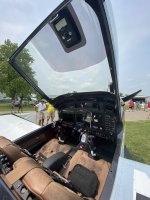I am debating of getting a dedicated aviation oxygen bottle or using the Inogen oxygen generator system since I sometimes will fly over 10,000 when flying in the western US.
I have never used oxygen before, I don't know anyone in my very small circle of pilot friends who have used oxygen or have airplanes that are equipped with oxygen.
My question: If I use a dedicated oxygen bottle such as from the Aerox, if the oxygen bottle is mounted in the back baggage area, do I need to turn on the oxygen valve to full before getting on the airplane? If I do that, will the oxygen get released into air and the bottle get emptied without anyone using it? Or is the oxygen get released each time I take in a breath? If I fly at 11,000 ft and wanting to get higher and thus need more oxygen, how can I increase the oxygen flow if the bottle is mounted in the back where pilot cannot reach? I know these are dumb question but the closest I've been to an oxygen system is the display rack at Aircraft Spruce.
Also, if you have an airplane in SoCal and it is equipped with oxygen, can I ask to talk with you and about looking at your setup, and how you use it?
Thanks.
I have never used oxygen before, I don't know anyone in my very small circle of pilot friends who have used oxygen or have airplanes that are equipped with oxygen.
My question: If I use a dedicated oxygen bottle such as from the Aerox, if the oxygen bottle is mounted in the back baggage area, do I need to turn on the oxygen valve to full before getting on the airplane? If I do that, will the oxygen get released into air and the bottle get emptied without anyone using it? Or is the oxygen get released each time I take in a breath? If I fly at 11,000 ft and wanting to get higher and thus need more oxygen, how can I increase the oxygen flow if the bottle is mounted in the back where pilot cannot reach? I know these are dumb question but the closest I've been to an oxygen system is the display rack at Aircraft Spruce.
Also, if you have an airplane in SoCal and it is equipped with oxygen, can I ask to talk with you and about looking at your setup, and how you use it?
Thanks.







